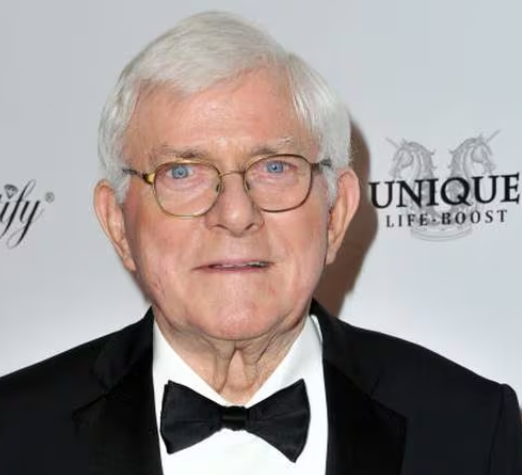Phil Donahue, who pioneered the issues-driven, audience-fueled television talk show format in Dayton, Ohio, later taking his program to WGN-9 in Chicago and, ultimately, New York, has died.
Donahue was 88 years of age. According to TMZ, he died yesterday following a long illness.
News of Donahue’s passing was first made known on NBC’s TODAY on Monday morning (8/19). From 1979-1988, he appeared as a regular contributor to the program in an era where Bryant Gumbel and Jane Pauley commanded huge audiences for the wake-up show.
Few details surrounding the cause of his death are known; he is survived by his wife of 40 years, Marlo Thomas.
For a generation, The Phil Donahue Show was a daytime staple, syndicated to markets across the U.S. It became nationally syndicated in 1970; the Cleveland-born journalist’s foray into televised talk programs began in Dayton, Ohio.
There, Donahue first honed his craft at WHIO-AM, as host of “Conversation Place.” He hosted the station’s afternoon shift, taking calls from listeners. After four years behind the mic, Donahue in 1967 departed and moved in front of the camera, working across town at the forerunner of WDTN-2, known as WLWD-TV and owned by Crosley Broadcasting. As Streamline Publishing sales associate and longtime Dayton media figure George Wymer recalls, Donahue featured atheist Madalyn Murray O’Hair as his first guest.
Hot-button topics would become a signature theme of his programs.
With a growing audience but largely linked only to Crosley-owned stations, “The Phil Donahue Show” went national in 1970. That success led Donahue in 1974 to relocate to Michigan Avenue and the Magnificent Mile, becoming Donahue and establishing itself as a signature program of then-Tribune Co. flagship TV property WGN.
In 1984, Donahue took his show to New York, relocating to a studio within 30 Rockefeller Plaza.
With audience participation breaking the mold, the show would remain largely successful across the 1970s and 1980s. In the 1990s, with a new breed of talk show hosts ranging from Oprah Winfrey and Sally Jessy Rapahel to Morton Downey Jr. and Maury Povich, Donahue’s style and signature delivery began to wane. Donahue concluded its run in September 1996.
After seven years of retirement, Donahue briefly revived his eponymous program on CNBC. It ran from July 2002-February 2003, and was canceled over a spat regarding his opposition to U.S. military involvement in Iraq.
While largely out of the public eye for the last decade, Donahue on May 3, 2024 was at the White House and awarded by President Biden the Presidential Medal of Freedom. At the event, Donahue was seen in a wheelchair.
A START IN RADIO NEWS
Phil Donahue’s career began in radio, at KYW — not in Philadelphia but in his hometown of Cleveland. That was in 1957. Other early career stints included serving as Program Director of WABJ Radio in Adrian, Mich., before taking a role as the morning news anchor of WHIO-AM in Dayton. This was in 1959.
When all was said and done with his career, Donahue could count 20 Emmy Awards, and a Peabody Award. He was inducted in 1993 to the Academy of Television Arts & Sciences Hall of Fame.
In his personal life, Thomas, famed for her time as an actress, was Donahue’s second wife. From 1958-1975, he was married to Margaret Cooney. Together, they had five children.
RBR+TVBR OBSERVATION
By Adam R Jacobson
Who knew that my 34-year career as a journalist, including my collegiate years, would begin with Phil Donahue? As a shy writer who had zero confidence in conducting an interview, in person, with anyone (those who know me will likely shake their heads in disbelief on that statement), an editor at The Eagle — American University’s student newspaper — had me accompany her to a taping in Washington, D.C. of Donahue.
It was 1991, I believe. Having Donahue in D.C. was a big deal — even in an era where flashy and trashy daytime television was on the rise. Phil Donahue was the “respectful” talk show host, and covering his appearance in Washington was worthy of a feature story in the AU weekly. Originally, I was there to observe the editor and how she would cover the story. But, it turns out it was a bait and switch — she rose her hand, asked a question, and became a part of the show. As any journalist with ethics would do, even as a student, she handed me the story to write since she was now a part of it.
I have a clipping of the article somewhere in a box, in storage. I couldn’t turn up a digital copy easily in the Internet Archive for The Eagle. But, somewhere there’s an article with my name as a “Staff Writer.” It was the first article I had ever written for the college newspaper that would prepare me for a career that has now led me to write an obituary on the very subject that got me my post-high school start.
Thank you, Phil Donahue. You broke the mold, stuck to your convictions, and were a good Catholic, too. Television owes you a bit of gratitude.





I would also point out Phil Donahue’s introduction of his live Town Hall Meetings between his U.S. TV audiences and their Russian contemporaries, hosted live on the other side by the Kremlin’s spokesman Vladimir Pozner Jr., who eventually moved to the U.S. to work with Donahue before eventually moving back to Moscow. According to Wikipedia, this was in the mid-1980’s.